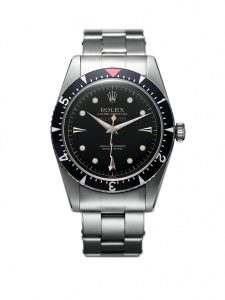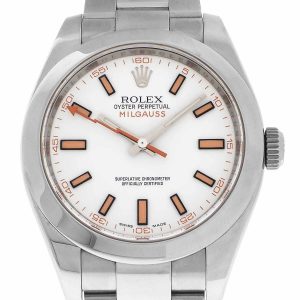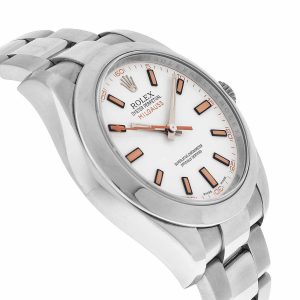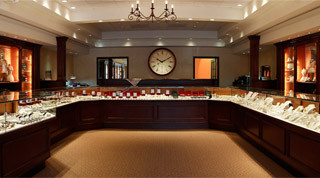The Attractions of the Rolex Milgauss
The distinctive Rolex Milgauss, one of its most specialized watches, launched in 1956. Now this often-neglected child of the space age is having a resurgence. Why? In a word, magnetism.
Magnetic fields are everywhere
To understand the need for the Milgauss, let’s step back to high school science for a moment.
Electronic magnetic fields (ELFs) are produced by the flow of electric currents. The unit for measuring the density of these fields is a “gauss,” originally named for the nineteenth-century German scientist Carl Friedrich Gauss. Now fields are measured in “tesla,” after Nikolas Tesla. (One tesla equals 10,000 gauss, or 10 milgauss.)
On a day to day basis, most human exposure to ELFs is limited. Household appliances may have a field as strong as 3 Milgauss, but ELFs are restricted to the area of transmission. As soon as you walk away, your exposure drops in half. So for most of us, ELFs are not an issue.
Why make an anti-magnetic Rolex?
Exposure to a strong electromagnetic field can magnetize the balance spring in a watch, causing the coils to attract each other and stick together. Ordinary mechanical watches may react to an ELF of 50 to 100 gauss.
In the fields of experimental science, that exposure is typically much higher than the day to day average. Nowadays, industrial technology can create magnetic fields of 3 to 10 Tesla. (30 to 100 Milgauss).
Never one to miss a milestone, Rolex recognized in 1956 the need for a watch that could continue to function despite increased exposure to magnetism. The answer was the 6541, a modification of the Submariner. They created a miniature soft iron Farraday cage inside to seal off the effects of a strong ELF on the mechanics. The only question was, would it work?


CERN tests the Milgauss
To find out if their new baby would perform, Rolex set the bar as high as possible. They went to their Swiss neighbor, CERN. The facility, best known for the discovery of the Higgs-Boson particle, was founded in 1951 by a consortium of European countries as a sort of UN for science. It houses the highest-energy particle accelerator in the world, essentially a magnetic generator so strong it can ram two neutrons together. If anyone needed a watch that could remain accurate in extreme magnetic exposure conditions, it was CERN.
Rolex gave CERN the 6541. The scientists tested it and confirmed that the 6541 functioned even when exposed to magnetic fields as high as 1000 gauss. And that’s where the Milgauss got its name. “Mille” means “1000” in French and “gauss,” as we said, is a unit of measurement of electromagnetic density.
Technology meets style
A watch this advanced needed equally cool style, and the Milgauss got a rocket-age look worthy of the times. Rolex gave it a unique lightning-bolt shaped second hand and a honeycomb face. Scientists loved it, but it was not a big commercial success. (Photo, courtesy of Rolex)
In an attempt to make it more appealing, Rolex came out in 1960 with the ref 1019, a major design overhaul that ditched the honeycomb face and traded the iconic lightning bolt for a straight seconds hand with a red tip. According to Timepiece Chronicle, a version was made without a luminous dial at the request of CERN, because the radioactive tritium paint interfered with their experiments. The “CERN dial” is a rare collectible, but the 1019 was not a success either, and in 1988, Rolex gave up, pulling the Milgauss from production.
The Milgauss gets a second chance
That might have been the end of the story, but in 2007 Rolex relaunched the Milgauss with the introduction of the ref 116400. They may have been inspired by the creation of the Parachrom hairspring two years earlier. If you invented a hairspring that is unaffected by magnetic fields, how could you resist testing it out in a Milgauss?


Rolex reworked the interior to match the latest innovations. The 116400 has Rolex’s signature COSC-certified calibre 3131 movement, shock-proof and magnetic resistant Parachrom hairspring made of niobium and zirconium, a paramagnetic escape wheel of nickel and phosphorus and a ferromagnetic shield that protects against electromagnetic fields, presumably much better than its earlier iteration.
Stylewise, the leash came off the creative department when it came to the 116400. The beloved lightning bolt seconds hand came back and they made it orange. But they weren’t done…
Green with envy: the Rolex Milgauss Glace Verte
Strangest of all the innovations is the lightly tinted green sapphire crystal. Exclusive to the Milgauss, it turns luminescent on the beveled edge. Rolex claims it doesn’t bother to patent Glace Verte (Green Glass) because it’s so hard to make no one else would even try! Look for the initials GV after the numbers.
In 2014, they came out with the Milgauss Z-Blue, with a bright blue dial. The irresistable watch was an instant hit and led the resurgence of interest in the line.
Rolex excellence comes standard
For all its eccentricities, the Milgauss is clearly a Rolex. It comes in a 40mm Oyster case with a 904L stainless steel Oyster bracelet. Like its sea-worthy brothers, it is waterproof to 100 meters and features the Twinlock crown to seal the interior.
Who is the Milgauss made for?
In the 1950s, ‘nerd’ was pejorative, and maybe the Milgauss, with its odd name and scientific heritage, was an invitation to get your glasses broken. Now that tech CEOs rule, vintage Milgauss watches are in hot demand. The lightning bolt and green glass crystal give it Comic-Con-worthy style, yet it beats with the reliable heart of a Rolex.


Want a Milgauss of your own? Call Ron at Palisade Jewelers and he will be happy to discuss your needs. 201 871 0400.



